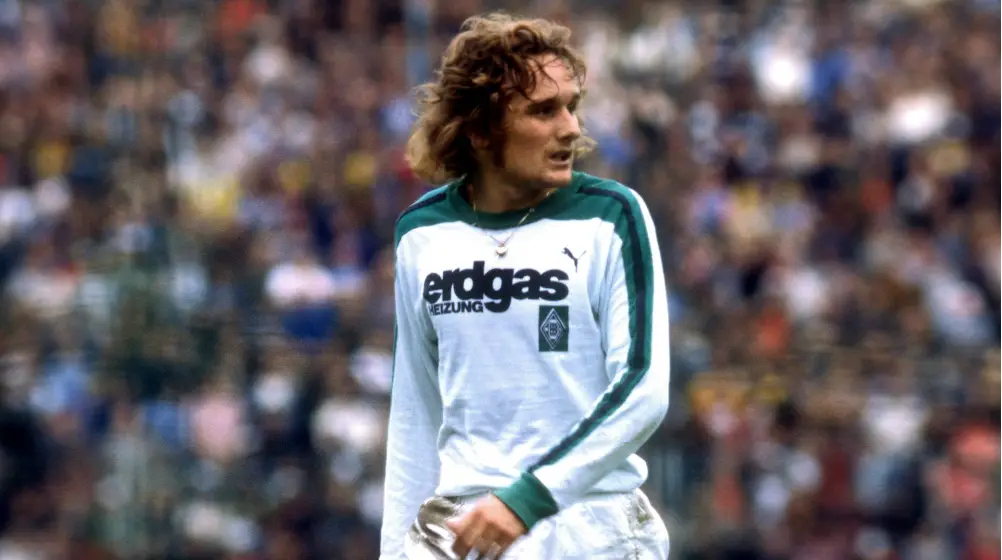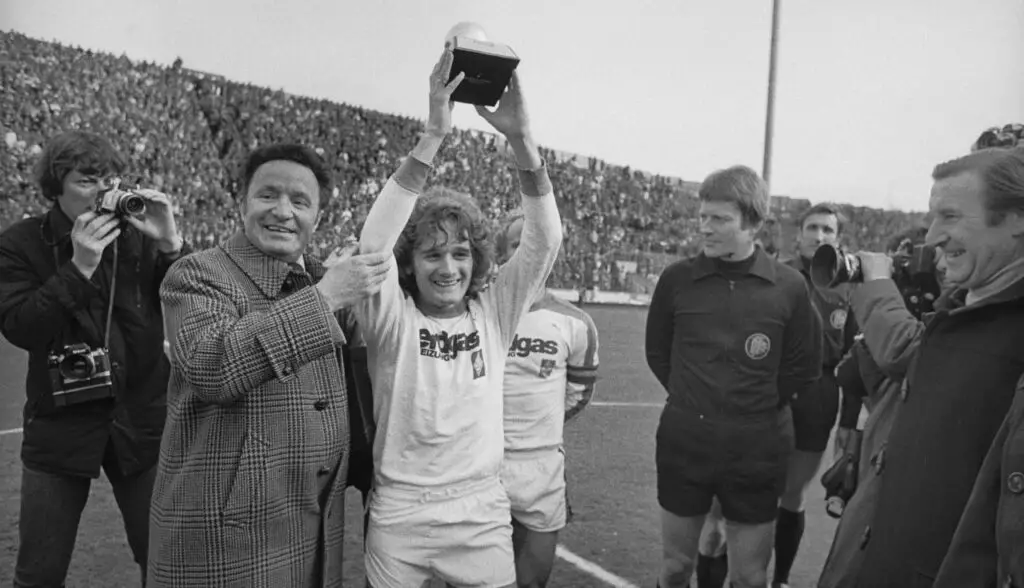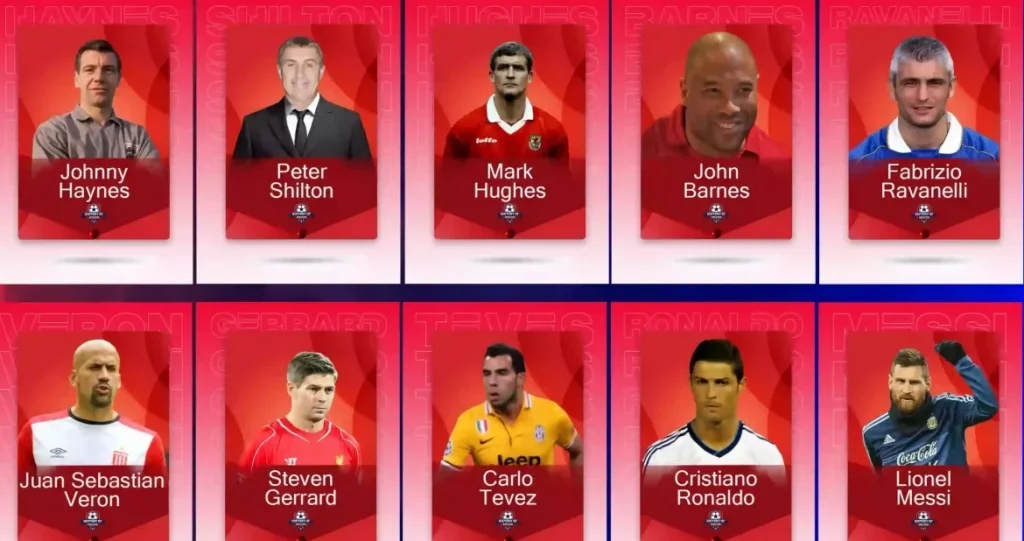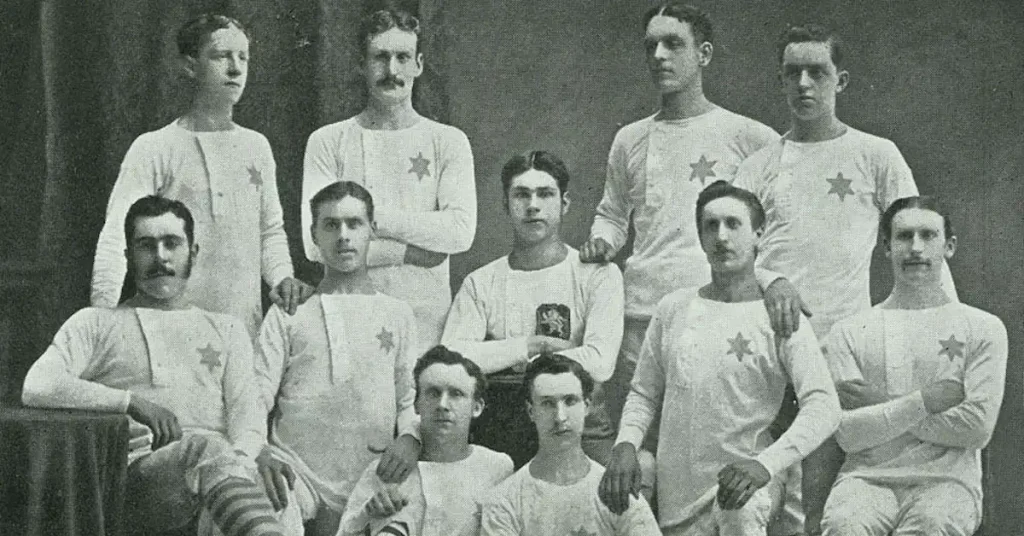Perhaps the greatest Danish outfielder of all time, alongside Micheal Laudrup, Simonsen played his best football at German side Borussia Monchengladbach. But the pinnacle of his prime came in the 76-77 season.
Allan Simonsen did not look like a world-class footballer, but he certainly played like one. An early prototype of the false-nine. A free-roaming forward for Borussia Monchengladbach with explosive pace and an appetite for goals, a precise finish backing his hunger up.
A Phenomenal Breakthrough
The year of 1975 marked a turning point in Simonsen’s career. Coming off the back of a storming breakthrough season the year before, in which he went from just 2 goals in 17 appearances across two seasons to 18 goals in 34 appearances.
Then, next season he’d prove his class, repeating a similar goal return of 16 in 34, as he led the line for a Gladbach side that won two titles in a row.
His Ballon d’Or was awarded to him for his exploits in 1977, which saw another successful season, but with significantly fewer goals for the Danish striker.
A now 24-year-old Simonsen had won two league titles in a row scoring more goals than in 77, but before this year he’d never gotten close to winning, never breaking into the top 20 despite being one of the best players in the Bundesliga the previous few years.
But, he needn’t worry about some grand conspiracy, because 76-77 saw things change drastically.
Following a third title in a row, Simonsen again playing all 34 games of the season, the France Football journalists seemed to have suddenly caught Simonsen fever.
Rightly so, he’d been exceptional the last few seasons, but there’s a feeling that Simonsen’s victory was more based on the previous two seasons than 1977.
An Off-Form Ballon d’Or Winner?

He’d score 12 in 34, which for a striker, even if he was often deployed as a winger, is hardly Ballon d’Or winning form.
But, as mentioned, he’d more than deserved to be in contention the previous years, so Simonsen’s win was by no means undeserved, 77 was just an odd year for him to do so well.
He was aided by a lack of major international tournaments, with odd number years in between big tournaments often producing some of the Ballon d’Or more surprising winners.
He’d help Gladbach to a European Cup Final, playing every minute of their European campaign where they eventually met Liverpool.
In the final, Simonsen scored to pull Gladbach level, with the Germans 1-0 down.
After 90 minutes, however, Liverpool would prove too much, eventually going on to win the game 3-1.
But really that was everything he’d achieved that year.
He did start the following season in impressive form. By the 19th of December, he had 11 goals in 19, which certainly kept him fresh in the minds of would-be Ballon d’Or voters.
A strong start to the European Cup also helped his case, suggesting that recency bias might have played a factor in Simonsen’s victory.
He was one of Europe’s most in-form attackers at the time, although as he carried on into 1978, his goal return would dwindle. In the second half of the Bundesliga, he only managed 6 goals.
In addition, he’d struggle with injury, missing a chance for revenge in the European Cup where they lost 4-2 on aggregate to Liverpool.
There wasn’t even a great International Qualifying campaign to rave about, Simonsen only played in 1 competitive international game in 1977, which was a 2-1 defeat to Poland. Though Simonsen did grab the only goal.
None of this is to say he wasn’t a good player, nor that he wasn’t deserving of Ballon d’Or contention, but the two seasons prior he was scoring more consistently.
The Competition: Why Simonsen was crowned Europe’s Best
In truth, it was a weaker year.
Johan Cruyff, who finished in 5th had output similar numbers in Spain, with 13 in 29 in the league, with a solid UEFA Cup showing of 5 in 7 as Barcelona faltered to Bilbao in the Quarter-Final.
Kevin Keegan who had finished just 3 points behind in second, had made a slow start to his 1977 campaign with Hamburg but had put on exemplary displays in the European Cup to bring European glory home to Liverpool the prior season.
Keegan could certainly feel aggrieved. He managed a similar league output to Simonsen but was Liverpool’s star man in Europe, his disappointing beginning to his Hamburg career likely another case of recency bias.
But the most perturbed should be 3 time Ballon d’Or winner Michel Platini.
He scored 19 League goals from midfield in 1977 for Nantes and proved the difference in France’s qualification for the 1978 World Cup.
He was in electric form and offered a similar goal return to Simonsen despite playing in midfield. The big difference maker however was the fact that Nantes weren’t in Europe.
Without that extra element of prestige, the case for Simonsen’s victory starts to take shape.
It was a year without a clear standout winner, reflected in the 3 vote gap between 3rd and 1st.
In retrospect, Keegan probably had the best case for his Liverpool form alone, but it’s completely understandable that Simonsen’s explosive start to the 77/78 campaign just about put him in pole position.
Keegan’s 4 in 18 to start his stay in Bavaria proved meagre in comparison to Simonsen’s 11 goals already.
As controversial as a decision it might seem, looking at the performances of his peers, a Simonsen win seems more than just making up for his lack of inclusion the past two years.
Nor is it just due to recency bias. As much as a glance at the stats tells you differently when we look at his rivals, they all fared similarly. Simonsen’s start to the new season just about gave him an edge.
He was a deserved winner of the 1977 Ballon d’Or, even if it wasn’t close to his best personal season.
Ballon d’Or 1977 Top 20
| Rank | Name | Club(s) | Nationality | Points |
|---|---|---|---|---|
| 1 | Allan Simonsen | West Germany Borussia Mönchengladbach | Denmark | 74 |
| 2 | Kevin Keegan | England Liverpool, West Germany Hamburger SV | England | 71 |
| 3 | Michel Platini | France Nancy | France | 70 |
| 4 | Roberto Bettega | Italy Juventus | Italy | 39 |
| 5 | Johan Cruyff | Spain Barcelona | Netherlands | 23 |
| 6 | Klaus Fischer | West Germany Schalke 04 | West Germany | 21 |
| 7 | Tibor Nyilasi | Hungary Ferencváros | Hungary | 13 |
| Rob Rensenbrink | Belgium Anderlecht | Netherlands | ||
| 9 | Dudu Georgescu | Romania Dinamo București | Romania | 6 |
| 10 | Emlyn Hughes | England Liverpool | England | 5 |
| Steve Heighway | England Liverpool | Ireland | ||
| Berti Vogts | West Germany Borussia Mönchengladbach | West Germany | ||
| 13 | Dominique Bathenay | France Saint-Étienne | France | 4 |
| Trevor Brooking | England West Ham United | England | ||
| Anders Linderoth | France Marseille | Sweden | ||
| Ronnie Hellström | West Germany 1. FC Kaiserslautern | Sweden | ||
| Franco Causio | Italy Juventus | Italy | ||
| 18 | Ruud Krol | Netherlands Ajax | Netherlands | 3 |
| Marius Trésor | France Marseille | France | ||
| 20 | Rainer Bonhof | West Germany Borussia Mönchengladbach | West Germany | 2 |
| Heinz Flohe | West Germany 1. FC Köln | West Germany | ||
| Ruud Geels | Netherlands Ajax | Netherlands | ||
| Dieter Müller | West Germany 1. FC Köln | West Germany | ||
| Pirri | Spain Real Madrid | Spain | ||
| Peter Shilton | England Nottingham Forest | England |
Trivia
- 3rd place Michel Platini would go on to win three Ballon d’Or’s in a row between 1983 and 1985
- Allan Simonsen would go on to shock the world by moving from Barcelona to English second-division side, Charlton Athletic, just 5 years after winning the Ballon d’Or, in 1982
- Simonsen to this day, remains the only Scandinavian player to win the Ballon d’Or




